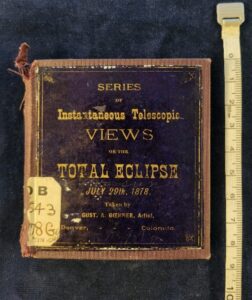The following post is by Allison Buser, Reference and Collections Assistant in the Rare Book and Special Collections Division.
In the middle of a clear, summer afternoon on July 29, 1878 in Denver, Colorado, the sky slowly darkened as Gustav A. Goehner carefully pointed his camera lens upward. Rather than feeling unease as the sun darkened high above, Goehner and many others were eager to witness the 1878 total solar eclipse that crossed the United States from Montana through Texas. Humans have always been captivated by eclipses—especially total solar eclipses and the bizarre experience of watching the new moon gradually creep across our view of the sun and dim the daytime world. This is as true in 2024 as it was in 1878. This week, many Americans prepare to observe the total eclipse which will pass over much of North America on April 8. In a total solar eclipse, the zenith point of fascination is the short period of otherworldly totality as all direct sunlight is obstructed, temperatures fall, and the black moon is haloed by the sun’s glowing corona. The Rare Book and Special Collections Division holds the delightful product of Goehner’s efforts to capture this ever-interesting phenomenon: a miniature book of his 1878 eclipse photography!

An immigrant from Württemberg, Germany to the United States, Gustav (or Gustave) Adolph Goehner arrived in Colorado by the mid-1870s. The high altitude and luck of a cloudless sky provided ideal conditions for him to capture the 1878 astronomical event as it passed through his new place of residence. This pocket-sized book of Goehner’s work holds an accordion foldout of fourteen black and white photographic prints. Each pasted-in photo (approx. 6.5 x 6.5 cm) includes a caption noting the time at which each recorded stage of the eclipse occurred. When the accordion is extended, one obtains a minute experience of observing the moon’s 1878 passage directly between sun and earth.


The Rocky Mountains were especially heralded as the most opportune site in the country to watch the much-anticipated total eclipse of 1878. Tourists and scientists from around the world to flocked to Colorado for the experience. Many scientists in the United States, including Thomas Edison and Maria Mitchell, launched western expeditions to high-altitude viewing points, seeking to make notable observations and discoveries during the event and place their work and the credentials of American science on the world stage. Mitchell’s description of the event, preserved for posterity in a publication of her journals, offers a beautiful description of the event that Gustav documented with his photographs:
The moon, so white in the sky, becomes densely black when it is closely ranging with the sun, and it shows itself as a black notch on the burning disc when the eclipse begins. …As totality approached, all again took their positions. The corona, which is the “glory” seen around the sun, was visible at least thirteen minutes before totality; each of the party took a look at this, and then all was silent, only the count, on and on, of the young woman at the chronometer. When totality came, even that ceased. How still it was!

Popular and scientific interest in the 1878 total solar eclipse likely created a business opportunity for Goehner, in addition to any personal interest in capturing the phenomenon. He immediately applied for copyright of his photos. In accordance with the Copyright Act of 1870, which required copies of all intellectual property registered for protection be deposited with the Library of Congress, he submitted this small copy of his photographic series to the Library. By legally protecting his exclusive right to all copies of his work, he presumably sought to sell his photography to those astronomically inclined or seeking a memento of the eclipse.

Although miniscule in size, this book of photographs encapsulates a larger astronomical fascination that spans human history. This tiny treasure is just one small example of the intriguing eclipse collection items that can be found in the Rare Book and Special Collections Division. During the month of April, come to the Rare Book and Special Collections Division Reading Room (LJ-239) and view them on display!
SOURCES
Goehner, Gustav Adolph. Series of instantaneous telescopic views of the total eclipse [of the sun] July 29th, 1878. Denver, Col. [s.n., 1878]. https://lccn.loc.gov/06014343
Mitchell, Maria, 1818-1889. Maria Mitchell : life, letters, and journals compiled by Phebe Mitchell Kendall. Boston : Lee and Shepard, 1896. p. 230-231. https://lccn.loc.gov/03012768
U.S. Census Bureau. 1900 United States Census, Schedule No. 1—Population. Ward 5, Minneapolis, Hennepin County, Minnesota. “Goehner, G.A.” U.S. National Archives and Records Administration.
FURTHER RESOURCES
Solar Eclipses: A Reference Guide – This guide from the Library of Congress’ Science, Technology and Business Division, highlights resources on solar eclipses and eclipse observation and photography, listing general works as well as guidebooks, eclipse expedition and observation reports, library blog posts and videos, internet websites and more.
Click here to subscribe to Bibliomania and never miss a post!
